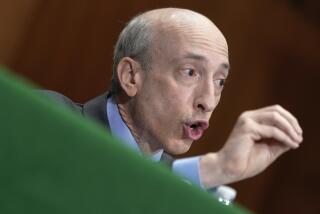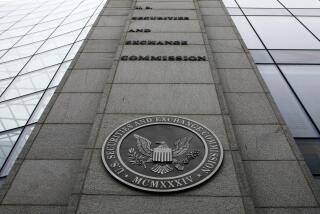Spy team is Wall Street regulator’s weapon against insider traders
ROCKVILLE, Md. — Cameron Funkhouser heads a spy agency that most Americans never knew existed.
His operation is based in a nondescript beige building in the leafy suburbs outside Washington, a short drive from the National Security Agency, the CIA and the FBI. Inside, dozens of analysts pore over a torrent of sophisticated data that has become a front line in an aggressive government battle.
Red flags pop up on their computers when something seems amiss, then investigators get to work tracking down leads. The most promising targets are identified in high-level meetings inside what the organization calls its war room.
This isn’t a hunt for terrorists. They’re snooping for Wall Street cheats: insider traders acting on hot — and illegal — stock tips.
“Every trade leaves a footprint,” said Funkhouser, who heads the Financial Industry Regulatory Authority’s surveillance operation. “Everybody who trades on insider information thinks they’ve committed the perfect crime and that they’re not going to be detected.”
Federal authorities have turned up the heat on Wall Street since the financial crisis punished the stock market and Bernard Madoff’s massive Ponzi scheme slammed unsuspecting investors. In the campaign, the FBI has treated financial criminals like mobsters and drug-runners, using wiretaps and a network of informants to bring down sophisticated rings.
At Finra, considered to be Wall Street’s own watchdog, some three dozen analysts are tasked with sifting through a staggering 6 billion stock trades every day. The work being done at the Office of Fraud Detection and Market Intelligence has become a vital piece of the government’s war on financial wrongdoers.
And these financial sleuths have developed a technological and investigative edge to ferret out hard-to-find insider traders both large and small.
Tips from Finra helped lead regulators and prosecutors to the most lucrative insider case ever, an alleged $276-million fraud linked to the inner circle of the legendary hedge fund SAC Capital Advisors. And that case helped lead to the bombshell indictment of the fund itself last week — a rare corporate prosecution alleging rampant insider trading over more than a decade.
Authorities have been circling the firm’s founder, investment guru Steven A. Cohen, in what observers see as an attempt to topple yet another Wall Street personality.
Other big fish snagged by the government’s crackdown include hedge fund titan Raj Rajaratnam and former Goldman Sachs director Rajat Gupta.
But Finra’s also watching small-time investors no one’s ever heard of.
Take Bryan Shaw, an Encino jewelry store owner who thought the stock tips he was getting from former KPMG senior auditor Scott London would fly below the radar. They didn’t.
It was information passed on by Finra that helped lead to their arrests in April, Assistant U.S. Atty. James Bowman said. They were taken down with the kind of fanfare usually reserved for mobsters or corrupt politicians.
The golfing buddies’ scheme, which raked in nearly $1.3 million in profit, thought their trades were too small to capture the attention of law enforcement.
But the FBI persuaded Shaw to aid in its investigation, and he agreed to wear a wire to help gain evidence of London’s role. To bolster their case, federal agents later snapped surveillance photos of both men in a money handoff at a Starbucks parking lot, all thanks to information originally provided by Finra.
“Finra does really an amazing job of connecting the dots,” said Bowman, who coordinates securities fraud prosecutions in the U.S. attorney’s office in Los Angeles. “The work they do is incredibly helpful.”
The successor to the National Assn. of Securities Dealers, Finra is an independent industry regulator and is funded by Wall Street, not taxpayers.
And although Finra’s enforcement efforts have won praise, the regulator has drawn criticism for lapses. Its own board issued a critical 2009 report after Finra’s failures to uncover Madoff’s scheme or that of fraudster R. Allen Stanford, who is serving a 110-year sentence for a $7-billion Ponzi scheme.
In response, the regulator folded its insider-trading surveillance program into the newly created fraud detection and intelligence office, which Funkhouser now leads. The office’s ranks include a former terrorism investigator as well as erstwhile homicide and robbery detectives.
Since the financial crisis, Finra has shown more zeal in aggressively pursuing cases no matter how insignificant they might seem, said Ernest Badway, a former enforcement attorney at the Securities and Exchange Commission who is now a white-collar defense attorney in New York and New Jersey.
“They’re going after every single type of insider case around,” Badway said.
The Wall Street watchdog has no subpoena power, so it turns over its findings to government agencies. And they’ve been turning in tips to the SEC at an unprecedented pace. The number of referrals last year reached 347, up from 259 in 2010.
This year the industry regulator is on track to match last year’s total referrals.
“There’s been no time in history that there’s been this regulatory pursuit of insider traders,” said Sam Draddy, a former SEC official who oversees Finra’s insider-trading unit.
Draddy’s team deploys sophisticated computer algorithms that check for unusual trading activity before major company developments, which are often when stock market cheaters try to game the financial system. For instance, quarterly earnings or announcements of mergers routinely shoot stocks higher or lower.
A program called Sonar — Securities Observation, News Analysis and Regulation — monitors financial news. The program factors in a slew of variables: price movements, historical volumes, and 52-week highs and lows.
Then there’s Sonar’s gotcha moment. An alarm sounds in the form of “a break” appearing on the computers of Finra analysts when the program detects any unusual trading ahead of big corporate news, and then managers wade through potential leads to decide which to follow.
Finra typically is investigating 300 to 400 cases of suspicious trading at any given time. More than half involve first-time cheaters who simply couldn’t help themselves when they came across lucrative inside information, Draddy said.
Some of the toughest cases involve organized insider-trading rings with tentacles reaching deep into corporate America. It’s not immediately clear who might be the source of information for those making suspect trades. Sometimes there is no obvious link, particularly if information is stolen.
Take the Golden Goose case.
In summer 2007, Finra’s alarm bells went off when Jamil Bouchareb, a Miami Beach trader, made a series of well-timed stock buys. He bought shares of companies just days before they were acquired.
Bouchareb’s business partner, girlfriend and even his parents made similarly suspicious trades. But they had no obvious connections to anyone privy to the deals. So the analysts — who routinely mine publicly available information: social media sites, career biographies and resumes — dug deeper.
It turned out that a common denominator was Bouchareb’s friend Matthew Devlin, then a Lehman Bros. stock broker in New York. Devlin was gleaning information about the mergers from his wife, a public relations executive, and tipping off friends. Because of their profitable tips, the couple were dubbed the Golden Goose. (His wife was not accused of wrongdoing.)
“The tippers can be hiding,” Draddy said. “These are not easy cases to make.”
Regulators’ determination was apparently lost on London, the former KPMG auditor. Despite the government’s widely publicized insider-trading crackdown, London seemed unaware.
At one point in the KPMG case, when Shaw grew worried authorities were on to him, London reassured him, according to court papers.
Insider trading is like counting cards at a casino in Las Vegas, London told Shaw: If you get caught, you’re simply asked to leave because they can’t prove it.






